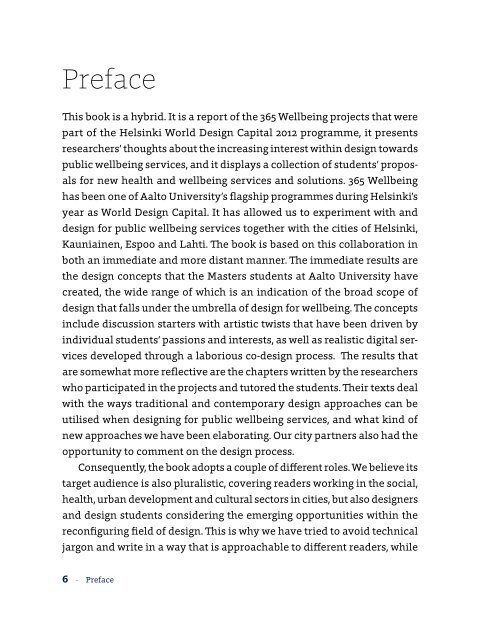Designing for wellbeing
Designing for wellbeing
Designing for wellbeing
You also want an ePaper? Increase the reach of your titles
YUMPU automatically turns print PDFs into web optimized ePapers that Google loves.
Preface<br />
This book is a hybrid. It is a report of the 365 Wellbeing projects that were<br />
part of the Helsinki World Design Capital 2012 programme, it presents<br />
researchers’ thoughts about the increasing interest within design towards<br />
public <strong>wellbeing</strong> services, and it displays a collection of students’ proposals<br />
<strong>for</strong> new health and <strong>wellbeing</strong> services and solutions. 365 Wellbeing<br />
has been one of Aalto University’s flagship programmes during Helsinki’s<br />
year as World Design Capital. It has allowed us to experiment with and<br />
design <strong>for</strong> public <strong>wellbeing</strong> services together with the cities of Helsinki,<br />
Kauniainen, Espoo and Lahti. The book is based on this collaboration in<br />
both an immediate and more distant manner. The immediate results are<br />
the design concepts that the Masters students at Aalto University have<br />
created, the wide range of which is an indication of the broad scope of<br />
design that falls under the umbrella of design <strong>for</strong> <strong>wellbeing</strong>. The concepts<br />
include discussion starters with artistic twists that have been driven by<br />
individual students’ passions and interests, as well as realistic digital services<br />
developed through a laborious co-design process. The results that<br />
are somewhat more reflective are the chapters written by the researchers<br />
who participated in the projects and tutored the students. Their texts deal<br />
with the ways traditional and contemporary design approaches can be<br />
utilised when designing <strong>for</strong> public <strong>wellbeing</strong> services, and what kind of<br />
new approaches we have been elaborating. Our city partners also had the<br />
opportunity to comment on the design process.<br />
Consequently, the book adopts a couple of different roles. We believe its<br />
target audience is also pluralistic, covering readers working in the social,<br />
health, urban development and cultural sectors in cities, but also designers<br />
and design students considering the emerging opportunities within the<br />
reconfiguring field of design. This is why we have tried to avoid technical<br />
jargon and write in a way that is approachable to different readers, while<br />
6 · Preface
















